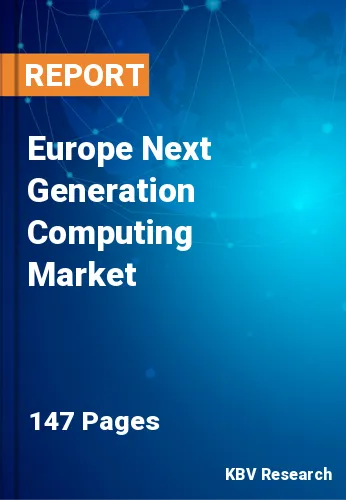The Europe Next Generation Computing Market would witness market growth of 17.5% CAGR during the forecast period (2022-2028).
Next-generation computing is also known as supercomputing, entails the usage of parallel computing to handle data at increased rates and accuracy while producing efficient outputs. Parallel processing is accomplished by spreading programmer instructions across multiple processors, resulting in a significant reduction in the time required to run algorithms. A group of computers is frequently used in systems, as their combined power can provide great computing capabilities. In other words, high-performance computing systems can simplify complex business processes. As a result, Next-generation computing systems are likely to become more popular.
Over the forecast period, the introduction of Exascale computation is likely to offer up new growth prospects for the next-generation computing market. The ability of computing devices to conduct a billion calculations per second is known as Exascale computing. Exascale computing can also help with improved simulation and modelling, which could help with economic competitiveness, energy, scientific discovery, and natural security. To successfully process enormous volumes of data, Next-generation computing systems demand better efficiency bandwidth and memory capacity, which Exascale computing can meet.
Next-Generation Computing is at the heart of important achievements and innovation in the digital decade, and it is a critical resource for Europe's future. Data is continually being generated in today's world, with data production increasing from 33 zettabytes in 2018. As a result, the computing landscape is shifting, with a growing number of data-intensive, mission-critical applications.
Next-Generation Computing is essential for analyzing and processing this increasing volume of data, as well as getting the most of every for citizens, corporations, researchers, and government agencies. It has a wide range of applications, from tracking and minimizing the impact of climate change to developing safer and more environmentally friendly cars, as well as boosting cyber security and pushing the boundaries of knowledge in practically every scientific subject.
The Germany market dominated the Europe Next Generation Computing Market by Country in 2021, and would continue to be a dominant market till 2028; thereby, achieving a market value of $30.9 billion by 2028. The UK market is experiencing a CAGR of 16.6% during (2022 - 2028). Additionally, The France market would exhibit a CAGR of 18.4% during (2022 - 2028).
Based on Type, the market is segmented into High Performance Computing, Quantum Computing, Energy Efficiency Computing, Memory Based Computing, Approximate & Probabilistic Computing, Brain Type Computing, Optical Computing, Thermodynamic Computing, and Others. Based on Component, the market is segmented into Hardware, Software, and Services. Based on Offering, the market is segmented into On-premise and Cloud. Based on Organization size, the market is segmented into Large Enterprises and Small & Medium Enterprises. Based on End User, the market is segmented into Government, BFSI & Telecom, Space & Defense, Energy & Power, Chemicals, Healthcare, Academia, and Others. Based on countries, the market is segmented into Germany, UK, France, Russia, Spain, Italy, and Rest of Europe.
Free Valuable Insights: The Global Next Generation Computing Market Size will Hit $465.7 Billion by 2028, at a CAGR of 18%
The market research report covers the analysis of key stake holders of the market. Key companies profiled in the report include IBM Corporation, Atos Group, Cisco Systems, Inc., Hewlett-Packard Enterprise Company, Amazon Web Services, Inc., Microsoft Corporation, Intel Corporation, Oracle Corporation, Google LLC, and Alibaba Group Holding Limited.
By Type
By Component
By Offering
By Organization size
By End User
By Country
Our team of dedicated experts can provide you with attractive expansion opportunities for your business.

